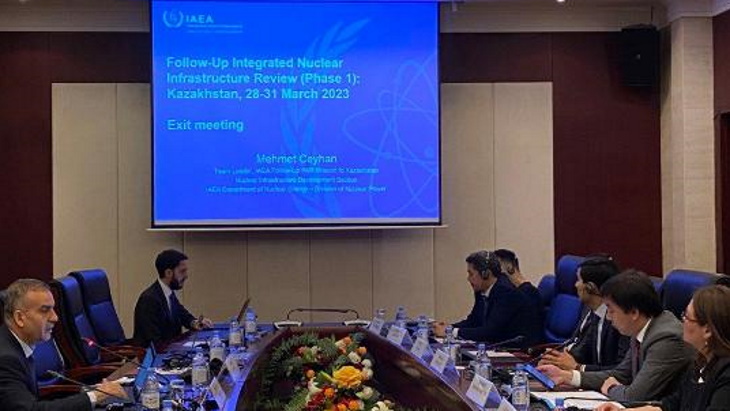Kazakhstan has made progress in implementing the recommendations of an International Atomic Energy Agency (IAEA) nuclear infrastructure review mission in 2016, a team of IAEA and international experts said. The four-day Integrated Nuclear Infrastructure Review (INIR) mission was conducted at the government's request.

(Image: Kazakh Ministry of Energy)
INIR missions enable representatives from IAEA member states to have in-depth discussions with international experts about conditions and best international practices in the development of a nuclear power programme.
A Russian-designed BN-350 sodium-cooled fast reactor operated near Aktau in Kazakhstan for 26 years until 1999, generating electricity and desalinating water. Kazakhstan currently operates research reactors as well as several other nuclear installations related to the front end of the nuclear fuel cycle, including uranium mining. The country has about 14% of the world's uranium resources and is the world's largest producer.
Kazakhstan's Ministry of Energy has proposed the potential reintroduction of nuclear power to reduce the country's reliance on fossil fuels, diversify its energy mix and reduce CO2 emissions. Kazakhstan Nuclear Power Plant (KNPP), which has been designated as the owner/operator of the future plant, began preparing a feasibility study in 2018 to justify the need for nuclear power, the choice of the location for plant construction and to review the plant's projected power output.
The follow-up INIR mission team travelled to Astana from 28 to 31 March to assess the level of implementation of the recommendations and suggestions of the INIR mission carried out in 2016.
The INIR mission reviewed the status of nuclear infrastructure development using the Phase 1 criteria of the IAEA's Milestones Approach, a comprehensive method to assist countries that are considering or planning their first nuclear power plant which splits the activities necessary to establish the infrastructure for a nuclear power programme into three progressive phases of development: consider, prepare and construct. The end of Phase 1 marks the readiness of a country to make a knowledgeable commitment to a nuclear power programme.
The team noted that Kazakhstan had fully addressed the recommendations in the areas of coordination of a nuclear power programme, financing of the nuclear power plant, emergency planning and radioactive waste management.
"Kazakhstan has made considerable effort to address the recommendations and suggestions made by the INIR team in 2016, which includes the preparatory work to inform the government's decision on whether to introduce a nuclear power programme," said mission team leader Mehmet Ceyhan, Senior Nuclear Engineer in the IAEA's Nuclear Infrastructure Development Section.
The team said that further work was needed to complete the comprehensive report that supports the decision-making process for the nuclear power programme to assess the funding requirements for nuclear power infrastructure, to plan for further development of the regulatory body and future owner/operator KNPP, and to develop a policy for industrial involvement of the nuclear power programme in the country.
"By requesting the INIR mission, Kazakhstan has demonstrated its interest in obtaining an objective, professional assessment of the readiness of its nuclear infrastructure to supply nuclear power to the country," said Zhandos Nurmaganbetov, Kazakhstan's Vice Minister of Energy. "The INIR mission is a valuable tool to identify areas for improvement and to develop the nuclear energy industry of Kazakhstan."
Researched and written by World Nuclear News